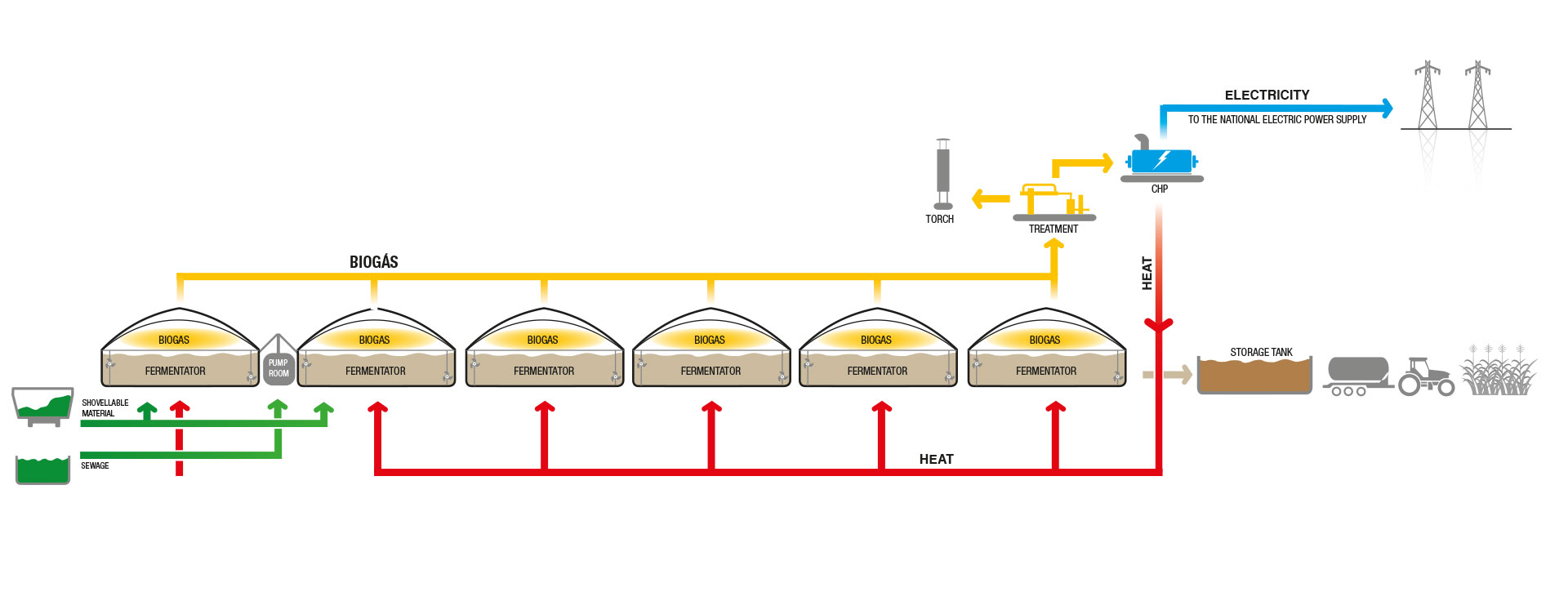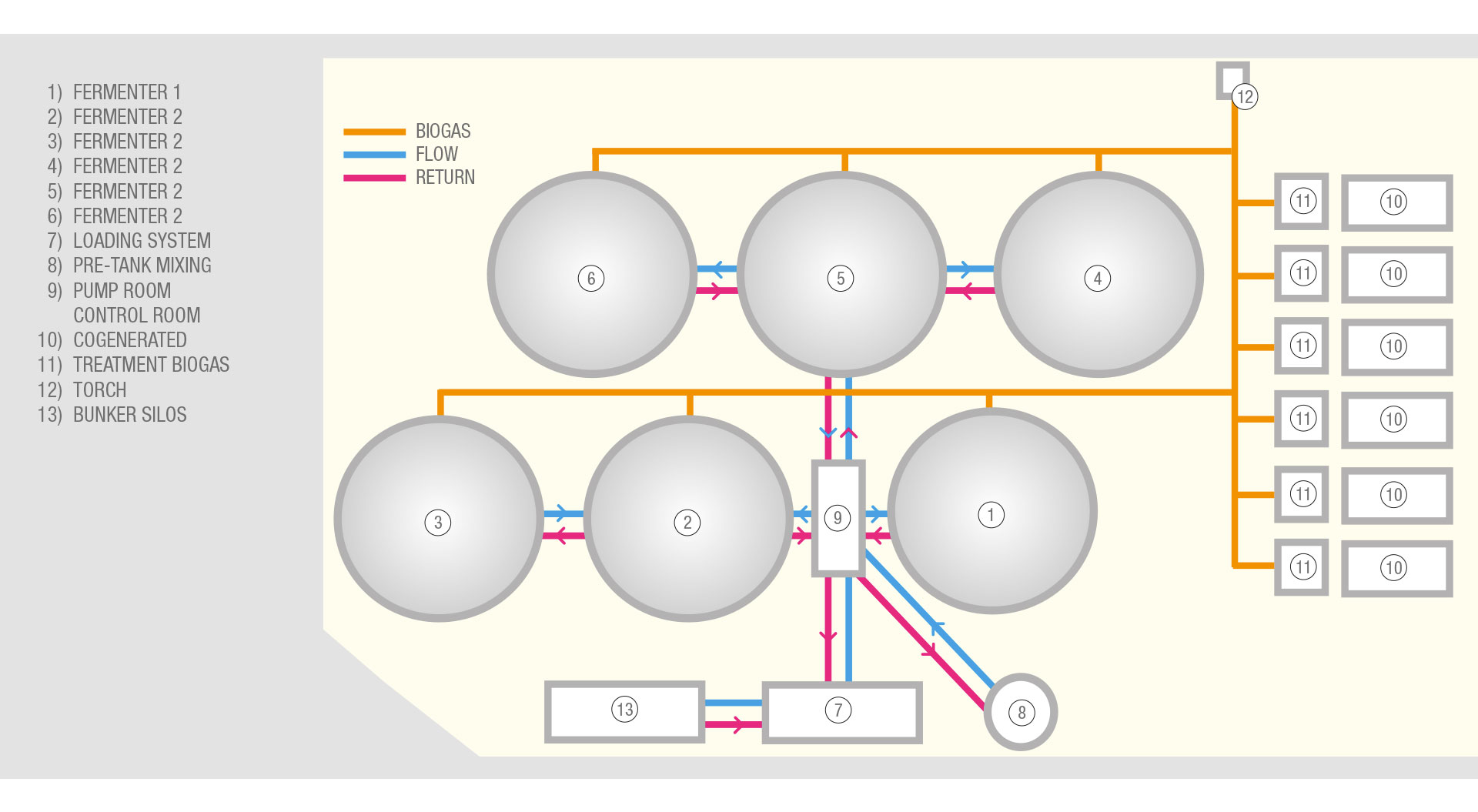Case History
BGA Argentina
It is one of the largest biogas plants in South America in terms of electrical power generated. Avellaneda‘s innovative and efficient Made in Italy biogas plant, perfectly integrated into the company’s production cycle, is located in the province of Santa Fe and produces 6,800kW at full power, which are fed directly into Argentina’s national electricity grid, meeting the needs of over 12,000 families, without waste and without odours, to the benefit of the environment and the community. In just five months the team delivered a 100% turnkey and operational system to the client, after passing all the performance tests. The plant is fed by waste from the production of bioethanol, corn flour, glycerine and pomace.
The biogas plant is an investment capable of efficiently completing the company’s self-sufficiency cycle.
TECHNICAL DATA SHEET // 6800 kWe

INSTALLED ELECTRIC POWER 6800 kWe
| INSTALLED ELECTRIC POWER | 6800 kWe | ||
|---|---|---|---|
| DOUBLE-STAGE MESOPHILIC PROCESS | |||
| Pre-tank: | n.2 | Ø 10 m | h=4m |
| Fermenters: | n.6 | Ø 30 m | h=6m |
| Biomass feeder: | n.2 | stirrers | 60mc |
| DAILY FEEDING PLAN | |||
|---|---|---|---|
| Stilage: | 400 ton | ||
| Corn grain: | 30,1 ton | ||
| ENERGY EFFICIENCY | |||
|---|---|---|---|
| Annual electricity production: | 38.250.000 kWh | ||
| Annual production of biogas: | 19.125.000 mc | ||
| Average concentration of methane (CH4) in biogas: | 52-54 % | ||
| COGENERATION GROUP | |||
|---|---|---|---|
| Manufacturer: | Stamford | ||
| Model: | PE 734 E | ||
| ENGINE | |||
|---|---|---|---|
| Manufacturer: | GE Jenbacher | ||
| Model: | JGS 320 GS BL D25 | ||

Biogas is one of the most widely used alternative sources of renewable energy production.
Biogas is the product of microbial degradation of organic substances in the absence of oxygen, a process commonly called anaerobic digestion. It is a mixture of gases, mainly composed of methane (CH4) and carbon dioxide (CO2).
Slurry from the barn, together with corn and triticale silage, is daily put into the two mainly digesters. Here they remain for about 100 days and then pass into the covered storage tank. The process is therefore of “double-stage” type and takes place at a temperature of 38-42 degrees (mesophilia). The “double-stage” technology allows a safe and elastic fermentation process but, above all, guarantees adequate retention times.
The covering of the storage ensures a complete degradation and therefore an efficient exploitation of the biomass used. Moreover, it also allows a greater reserve of biogas and a better desulphurisation (removal of H2S). Desulphurisation is biological, by injection of very small amounts of oxygen. The internal structure and a desulphurisation network offer an excellent surface for the colonisation of the desulphuriser bacteria. The biogas produced is conveyed to the cogenerator, which produces electricity and thermal energy.
The electricity is transferred to the public grid, the heat is reused partly for the fermentation process, partly for the district heating of barns and offices. At the end of the fermentation process the digestate is obtained: a liquid material, completely odourless, with very high agronomic value, with improved characteristics compared to the raw material.
The digestate undergoes a process of solid/liquid separation: the solid that has the consistency, appearance and smell of a “soil-humus”, is distributed in the fields with a manure spreader or sold to specific users such as flower-gardeners.
TO THE BENEFIT OF WATER, AIR AND SOIL QUALITY.









